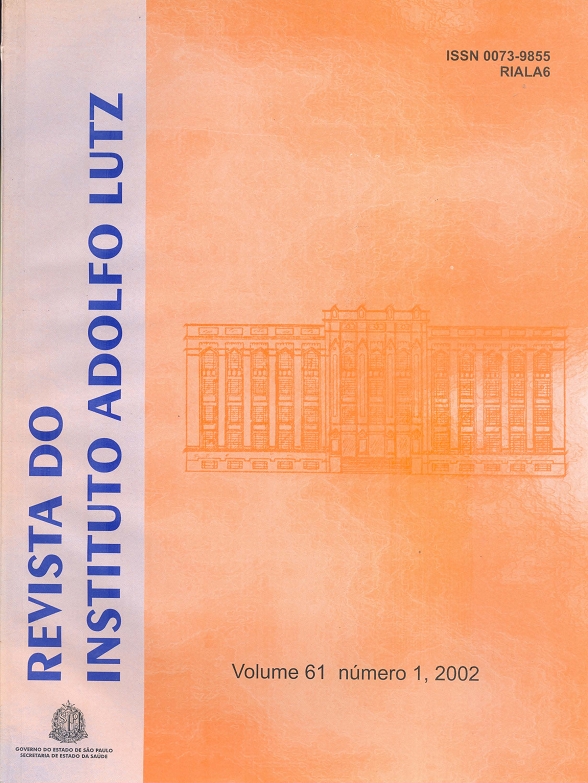Abstract
Studies that are accomplished to check the occurrence, epidemiology and risk factors to outbreaks of intestine diseases of hydric transmission such as the bacterial and viral gastroenteritis have made it possible to use strategies and control of these infections. However, the outbreaks caused by parasitic agents still need more attentions. The lack of standard methodology to detect them in different foods and water makes it difficult to clarify and, as a consequence, to subnotify the cases that have occurred. This study aimed to demonstrate the presence of bacterial and parasitic agents in seven water from natural springs of public utility located in Sorocaba and Votorantim cities – São Paulo state, analyzing environmental factors and source maintenance conditions. For the parasitological research were used different techniques of concentration: sediment was observed by optical microscopy; smears were prepared and stained by auramina and Kinyoun and were examined with oil immersion objective. The bacteriological methods were used the “Standart Methods for the examination of water and wastewater” and “Compendium of methods for the microbiological examination of foods”. The bacteriologic results showed the contamination of total coliforms in all samples, the presence of fecal coliforms was in 6 samples. The parasitologic results showed presence...
References
1. American Public Health Association. Compendium of Methods for the Microbiological Examination of Foods. vol. 3, 1.972
2. Balatbat, A. B. et al. Detection of Cryptosporidium parvum DNA in human feces by nested PCR. J.Clin. Microbiol., 34(7): 1769-1772, 1996.
3. Baker, J.; Muller, R.; Rollinson, D. Opportunistic protozoa in humans. Advances in Parasitology. San Diego, Academic press, 1998. v. 40.
4. Baraldi, S. R.; Marque, E. G. L.; Dias, R. M. D. S. Ocorrência de Cryptosporidium parvum e Isospora belli na região de Campinas, SP. Rev. Inst. Adolfo Lutz, 58 (1): 97–103, 1999.
5. Carli, G. A. De.; Saraiva, P.J. Diagnóstico de laboratório da criptosporidiose humana. Rev. Bras. Anal. Clin., 23(2): 26-30, 1991.
6. Cimerman, S.; Cimerman, B.; Lewi, D. S. Prevalence of intestinal parasitic infections in patients with acquired immunodeficiency syndrome in Brazil. Int. J. Infect Dis., 3(4): 203-6, 1999.
7. Craczyk, T.K. et al. Environmental and geographical factors contributing to watershed contamination with Cryptosporidium parvum oocysts. Environ res, 82(3): 263-71, 2000.
8. Deng. M. Q.; Cliver, D. O. Comparative detection of Cryptosporidium parvum oocysts from apple juice. Int. J. Food Microbiol, 54(3): 155-62, 2000.
9. Dolej, S. P. et al. Monitoring of Cryptosporidium and Giardia in Czech drinking water sources.Schriftenr . Rev. Wasser Boden Lufthyg. , 105: 147-51, 2000.
10. Eaton, A. D.; Clesceri, L. S.; Greenberg, A. E. Standard Methods for the examination of water and wastewater, 19th ed., 1995. 9711 A, 9711 B,9711 C, 10200 C – 9-109 –117.
11. Edwards, P. R.; Ewing, W. H. Identification of enterobacteriacea, 3rd ed., Minneapolis, Burges publ., 1978. p. 338
12. Fayer, R. et al. Waterborne and foodborne parasites. Food safety: Foodborne illness, 42: 789-808, 1998.
13. Gallaher, M. M. et al. Cryptosporidium and surface water. A. J. P.H January, vol.79, nº 1, 1989.
14. Guerrant, D. L. Cryptosporidiosis: An emmerging, highly infectious threat. Emmerging Infect Dis., 3(1), 1997.
15. Gelli, D. S. et al. Condições higiênico-sanitárias de hortaliças comercializadas na cidade de São Paulo, S.P., Brasil. Rev. Inst. Adolfo Lutz, 39(1): 37-43, 1979.
16. Ignatius, R. et al. Efficacy of different methods for detections of low Cryptosporidium parvum oocyst numbers or antigen concentrations in stool specimens. Eur. J. Clin. Microbiol Infect Dis, 16(10): 732-6, 1997.
17. Kaku, M et al. Surto alimentar por Salmonella enteritidis no Noroeste do Estado de São Paulo. Brasil. Rev. Saúde Pública, 29 (2): 127-31, 1995.
18. Kehl, K. S.; Cicirello, H.; Havens, P. L. Comparison of four different methods for detection of Cryptosporidium species. J. Clin. Mixcrobiol, 33(2): 416-8, 1999.
19. Llinares, F. J. B. et al. Identifications of Cryptosporidium felis in a cow by morphologic and molecular methods. Applied and Environmental Microbiology, Apr.1999, p1455-1458.
20. Neves, D. P. Parasitologia Humana, 8ª ed., Rio de Janeiro, ed. Atheneu , 1991. Cap. 17, p. 177-82.
21. Ooi, P. L. et al. A shipyard outbreak of salmonellosis traced to contamined fruits and vegetables. Ann Acad Med. Singapore, 26 (5): 539 – 43, 1997.
22. Pessoa, G. V. A.; Silva, E. A. M. Milieu pour l’identification presomptive rapide des enterobacteries, des Aeromonas e des Vibrions. Ann. Microbiol., Paris, Seccion A 125: 341-7, 1994.
23. Pieniazek,N. J. et al. New Cryptosporidium genotypes in HIV – infected persons. Emerging infectious Diseases, 5: 444-449, 1999.
24. Ryan, M. J. et al. Risk factors for outbreaks of infectious intestinal disease linked to domestic catering. Rev. Commun. Dis.Rep. CDR, 6 (13): R 179-83, 1996.
25. Silva, J. P. et al. Estudo da contaminação por enteroparasitas em hortaliças comercializadas nos supermercados da cidade do Rio de Janeiro. Revista da Sociedade Brasileira de Medicina Tropical; 28(3): 273-41, 1995.
26. Spano, F. et al. Multilocus genotypic analysis of Cryptosporidium parvum isolates from different hosts and geographical origins. J. Clin. Microbiol., 36: 3255-3259.
27. Tapia De Daza, M. S.; Diaz, R. V. Consideraciones ecologicas y de inocuidade alimentaria en productos de origen vegetal. Arch latinoam. Nutri, 44(4): 232-41, 1994.
28. Tymenestsky, M. C. S. T. et al. Rotavírus, adenovírus, astrovírus, calicevírus e “small round virus particles” em fezes de crianças com e sem diarréia aguda, no período de 1987 a 1988, na grande São Paulo. Rev. Inst. Med. trop. S. Paulo, 35(3): 275-280, 1993.
29. Widmer, G. Genetic heterogeneity and PCR detection of Cryptosporidium parvum. Adv. Parasitol., 40: 223-39, 1998.

This work is licensed under a Creative Commons Attribution 4.0 International License.
Copyright (c) 2002 Revista do Instituto Adolfo Lutz
